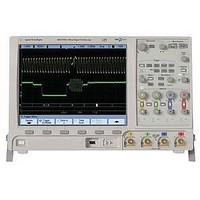DSO7034A-GSA AGILENT TECHNOLOGIES, DSO7034A-GSA Datasheet - Page 6

DSO7034A-GSA
Manufacturer Part Number
DSO7034A-GSA
Description
69R7202
Manufacturer
AGILENT TECHNOLOGIES
Datasheet
1.MSO7000-SGM.pdf
(28 pages)
Specifications of DSO7034A-GSA
Scope Type
Digital
Scope Channels
4 Scope
Bandwidth
350MHz
Meter Display Type
XGA LCD
Sampling Rate
2GSPS
Input Impedance
1Mohm
Rise Time
1ns
Input Voltage
40V P-p
Rohs Compliant
NA
Why does a fast update rate matter?
While bandwidth, sample rate and memory depth are key criteria for
deciding which scope to purchase, an equally important characteristic
is update rate.
What is update rate?
Update rate is how many waveforms acquisitions per seconds you
scope can acquire, process, and display. Oscilloscope “dead-time” is
the time it takes for a scope to process and then display an acquired
waveform before re-arming it’s triggering for the next acquisition. For
traditional scopes, this time is often orders of magnitude greater than
acquisition time on fast time-per-division settings.
If a glitch occurs during the scope’s dead-time, it won’t be captured.
The key to improving the probability of capturing a signal anomaly
during the scope acquisition time is to minimize dead-time.
Oscilloscope vendors usually specify what their scope’s “best-case”
waveform update rates are. Some scope architectures suffer from
factors that can seriously degrade the “best-case” update rates spec.
Agilent’s 7000 Series architecture delivers the world’s fastest update
rate when using:
Why is update rate important?
1.
2.
3.
Update rates directly affect a scope probability of capturing and dis-
playing infrequent and random events. Slow update rates will cause a
scope to miss subtle or infrequent signal details.
6
Responsiveness. If you rotate the timebase control, you expect
the oscilloscope to respond immediately – not seconds later after
the scope fi nishes processing data.
Signal detail. Fast waveform update rates improve the display
quality of the waveform that you see on screen.
Certainty. Fast waveform update rates improve the scope’s prob-
ability of capturing random and infrequent events.
• Analog channels
• Deep memory
• Analog and digital
• Serial decode
Improves probability of capturing
infrequent events
Improves instrument responsiveness
Improves scope display quality










